Anthurium and Spathiphyllum are popular tropical ornamental plants. They have lush leaves and exotic flowers and are prized for interior decoration in both residential and public settings.
Anthurium and Spathiphyllum are among the many plants in the Araceae family that are commercially cultivated as tropical ornamentals. Members of this plant family, including Anthurium and Spathiphyllum, are commonly referred to as aroids. The Araceae family includes at least 10 important ornamental tropical foliage plant genera.
Anthurium, also called flamingo lily, exhibit large, showy-red, orange, pink or white flowers arising from plants with glossy, arrow-shaped evergreen leaves. Anthuriums are often cropped for cut flowers, and large-sized Anthurium plants that yield long stems are favored for the floral market. New interspecific hybrids—such as Anthurium X 'Lady Jane' and Anthurium X 'Southern Blush'—are popular for the tropical flowering-foliage market because of their overall smaller size. Anthurium X 'Red Hot' (Henny 1999; Henny et al. 2008) is one such interspecific hybrid that exhibits numerous showy-red spathes and a compact, freely branching growth habit (Figure 1).
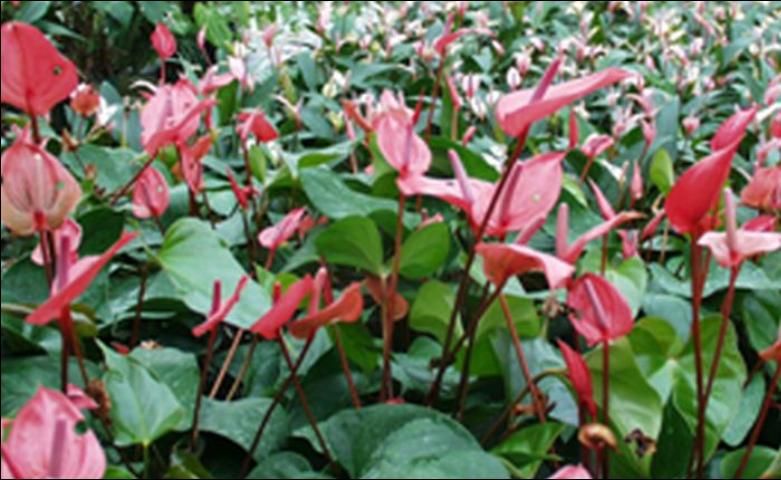
Spathiphyllum has become one of the most popular foliage-plant genus in the foliage industry. The wholesale value of finished Spathiphyllum totaled $32 million in 1998 (USDA 1999). These easy-care, attractive plants, commonly called peace lily, originate from the tropical rainforests of Central America. The plants have dark, evergreen foliage. Spathiphyllum cultivars are popular interiorscape plants in part because sizes available on the market range from very small varieties, such as 'Petite', to the larger forms of 'Mauna Loa' and 'Sensation'. From an ornamental viewpoint, the spathes and spadices (technically both are part of an inflorescence) are called flowers and consist of a white, sail-shaped spathe surrounding a spadix (Chen et al. 2003).
Market demand for new varieties of both Anthurium and Spathiphyllum has stimulated interest in breeding new cultivars. However, hybridization within the aroid family can be difficult to achieve because of sporadic flower production and specific requirements for successful pollination. Research by the Foliage Breeding Program at the UF/IFAS Mid-Florida Research and Education Center (MREC)–Apopka has given plant breeders new techniques to manipulate flowering and pollination in ornamental aroids for hybridization purposes. These techniques improve breeding potential for Anthurium, Spathiphyllum, and other aroid genera that were previously difficult to hybridize.
Factors Affecting Flowering
For breeding purposes, flower production is vital. Pollinations can take place only when parents with desired traits are blooming simultaneously. Therefore, careful planning is required to ensure a sufficient supply of flowers. Differences in the natural flowering cycles, even within the same genus, can be frustrating for breeders of tropical plants. Flowering times may be affected by environmental conditions. For example, in a greenhouse heated to a minimum night temperature of 60°F, plants of the same species will flower approximately one month earlier than those in a comparable greenhouse heated to 50°F. Cultural conditions—such as light, irrigation and nutrition—can affect flower initiation. Plant size and maturity can also be factors.
In the case of Spathiphyllum, natural flowering occurs once annually—in late winter or, in Central Florida, in very early spring. However, different Spathiphyllum species and cultivars may not flower simultaneously or at all. Flower production in Anthurium plants is not a problem since, once mature, plants produce flowers continuously throughout the year.
Flower Induction
In Spathiphyllum the potential barrier to breeding caused by flower unavailability can be overcome by the use of gibberellic-acid (GA3) sprays to stimulate flowering. At the UF/IFAS MREC in Apopka, research in the aroid-breeding program showed that treatment of Spathiphyllum with gibberellic-acid (GA3) sprays induces plants to flower throughout the year (Henny 1981).
Treatment generally consists of a single foliar spray of 250 ppm GA3 from a commercially available source (GibGro, 4% gibberellic acid, Agtrol Chemical Products, Houston, Texas 77074). Following treatment, plants flower within three-to-five months depending on the time of year. Flowers will appear more quickly if greenhouse temperatures are warm and the crop is rapidly growing. Within a genus, different species and cultivars generally flower close together following GA3-treatment, so potential parental selection can be controlled. An additional benefit of using GA3 to induce flowering is that treated plants produce more flowers than plants flowering under natural conditions. Some inflorescences produced following GA3-treatment may be deformed, but no detrimental effects on fertility—as measured by pollen production or seed set—have been observed.
Flower Structure
Anthurium and Spathiphyllum produce bisexual flowers (Figures 2 and 3). Their inflorescences consist of a spadix enclosed by a spathe. The spadix is a fleshy spike covered with many small, complete flowers. (The term "complete" indicates that male and female structures are contained within each single floret.)
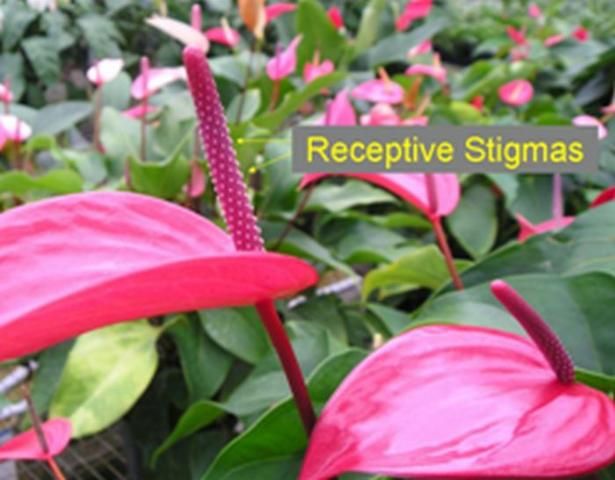
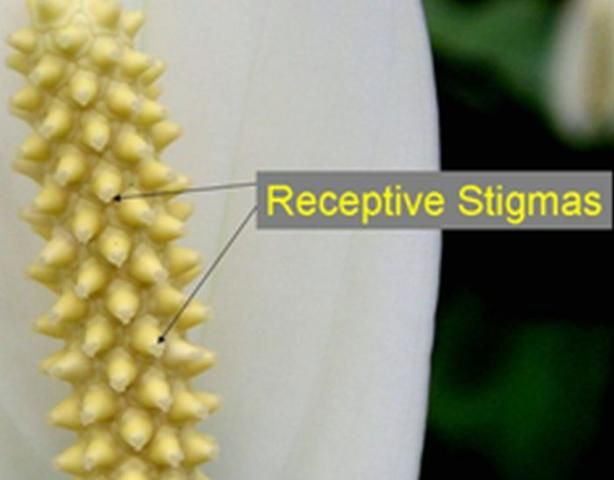
Pollen Collection and Transfer
In Anthurium and Spathiphyllum (aroid genera with bisexual flowers), the spathe unfurls and exposes the spadix several days before flowers are receptive for breeding. The unfurling of the spathe reveals numerous, uniformly sized bisexual flowers located along the entire spadix. In Anthurium, new flowers become receptive each day, beginning at the spadix base and advancing gradually towards the tip over a two-week period (Figure 2). Pistillate (female) receptivity is indicated by a glistening shine of stigmatic surfaces and stickiness to the touch. Small drops of exudate are sometimes present. Flowers may remain receptive for more than one day. In contrast, all flowers on a Spathiphyllum spadix mature simultaneously (Figure 3).
The stigmatic surfaces of both Anthurium and Spathiphyllum become dry and brown before pollen is dehisced, so floral emasculation is not required. Anthurium pollen begins to appear along the spadix, usually at the bottom first and then proceeds towards the tip (Figure 4). Anthurium pollen is produced for up to two weeks because of the differences in the maturation of individual pistillate flowers. Anthurium pollen is not dispersed by wind. To transfer the pollen to the receptive female flowers, collect it on your fingertips then gently rub it onto receptive stigmas (Figure 2).
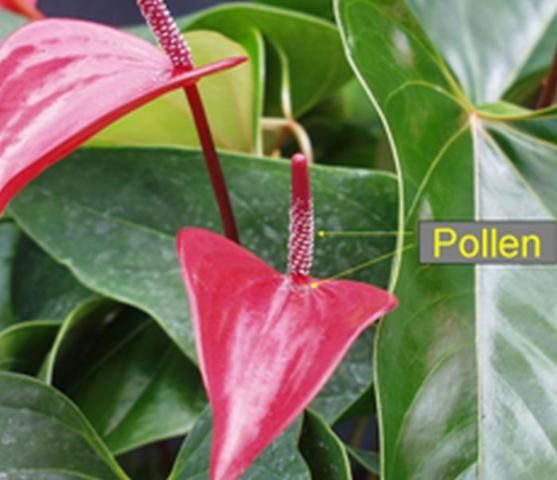
A Spathiphyllum inflorescence will produce pollen over a period of three-to-four days (Figure 5). The pollen of Spathiphyllum is lighter and may be dispersed by air currents, so a brush should be used. Before attempting pollination, gently tap the Spathiphyllum inflorescence over a container, and collect the pollen as it falls. Subsequent transfers are made using a soft brush.
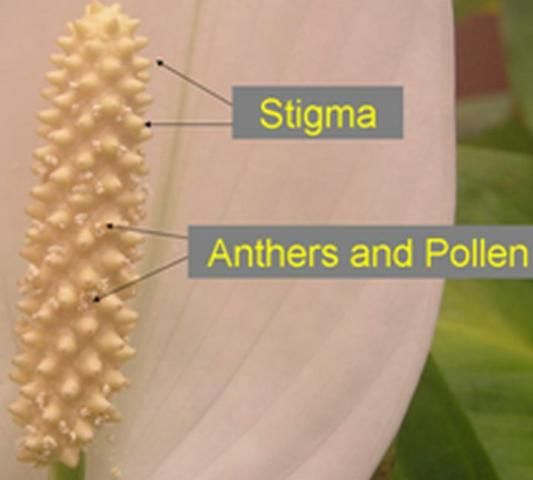
Pollen Storage
It is always best to use fresh pollen. However, if pollen is in short supply, it can be stored in a container in a high-humidity environment in a refrigerator. Collect the pollen in a container, such as a petri dish. Place a lid over the petri dish, and set it on top of a wet paper towel or other moistened material. Enclose the wrapped petri dish within a sealed storage container. At no time should the pollen be directly in contact with the wet paper towel. Avoid splashing water droplets onto the pollen. Spathiphyllum pollen may be stored for several days or weeks if necessary (Henny 2000).
Seed Production
To achieve maximum seed production, an Anthurium spadix needs to be pollinated more than once. However, it is possible to fertilize an entire Spathiphyllum spadix with a single pollination. To ensure seed set for Anthurium or Spathiphyllum, no special environmental manipulation—such as controlling relative humidity—is needed after pollen transfer. Pollinated flowers develop mature fruits within four-to-six months. Anthurium fruit will require up to five-to-eight months to mature. As seeds mature, Anthurium and Spathiphyllum spadices begin to turn to a yellowish color and soften.
Breeding for ornamental tropical foliage plants can be a lengthy process due to the limited numbers of seed obtainable and prolonged germination time. Several years may be needed to grow the hybrids to reach sufficient size for evaluation. Once a hybrid is selected and tested, tissue-culture methods may be applied so that a new aroid hybrid cultivar can be increased rapidly enough to reach commercial production levels within two-to-three years. The production of new hybrids leads to new plant introductions, and these foundations keep the foliage market fresh and profitable.
Literature Cited
Chen, J., D.B. McConnell, R.J. Henny, and K.C. Everitt. 2003. Cultural guidelines for commercial production of interiorscape Spathiphyllum. ENH958. Gainesville: University of Florida Institute of Food and Agricultural Sciences. https://edis.ifas.ufl.edu/EP161.
Henny, R. J. 'Red Hot' Anthurium. 1999. HortScience. 34(1): 153–154.
Henny, R.J., J. Chen and T.A. Mellich. 2008. New Florida Foliage Plant Cultivar: Red Hot Anthurium. ENH1099. Gainesville: University of Florida Institute of Food and Agricultural Sciences. https://edis.ifas.ufl.edu/EP363.
Henny, R.J. 1981. Promotion of flowering in Spathiphyllum 'Mauna Loa' with. Gibberellic Acid. HortScience 16 (4): 554–555.
Henny, R.J. 2000. Breeding ornamental aroids. p. 121–132. In: D.J. Callaway and M.B. Callaway (eds.), Breeding ornamental plants. Timber Press, Portland, OR.
USDA (United States Department of Agriculture). 1999. Floriculture crops 1998 Summary. Washington, DC.